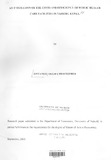| dc.description.abstract | This study estimated the costs and efficiency of selected public health facilities in the provision of outpatient care in the city of Nairobi during the years 1999 and 2000. Both Secondary and primary data were used. The combinations of purposive and judgmental sampling procedures were used to collect data, while the stochastic frontier model provided the framework for our analysis.
Generally, the estimated results strongly indicated that the number of outpatient visits and costs of labour and drugs were important determinants of the costs and efficiency of public health facilities in Nairobi. On average, the study revealed an average of about 6.6% level of inefficiency within the facilities. This was particularly attributed to limited funding, shortages of medical and non-medical staff, and lack of appropriate drug distribution and management/dispensation practices among others. The results further showed that the health facilities operated with declining average costs and increasing teturns to variable factor inputs.
The most notable implication of these findings to policy is that, in the short run, increased coverage and access to outpatient health care services in Nairobi can be achieved at relatively lower incremental costs. These and other results were used to make recommendations | en_US |

